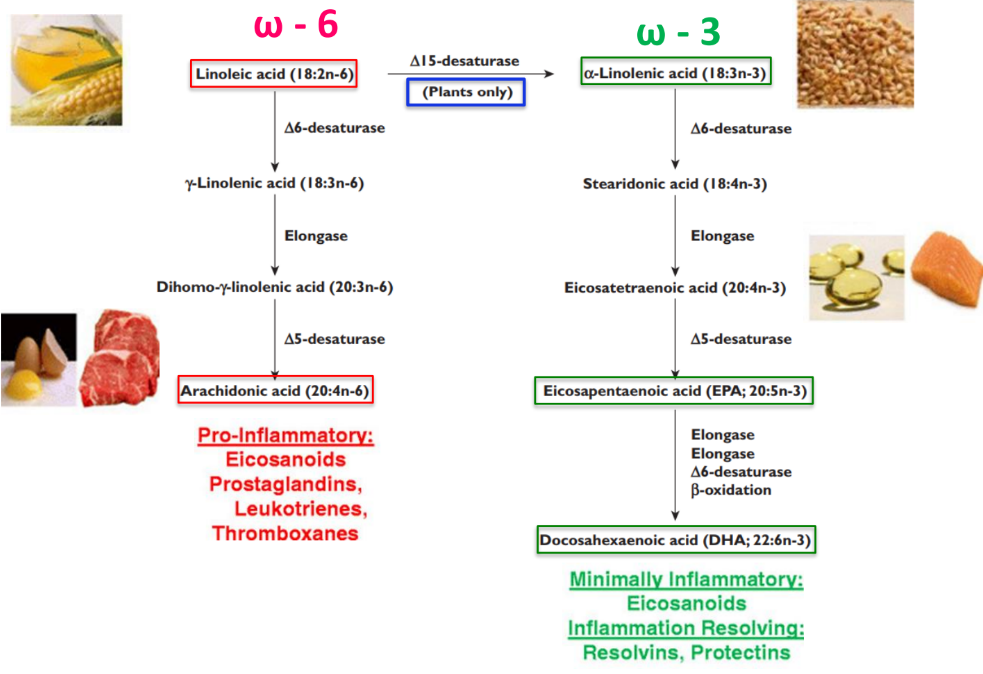10.1 Characteristics of Fatty Acids
Figure 10.3: Some Characteristics of Fatty Acids
Fatty acids are the simplest lipids (i.e., “building blocks” for other more complex lipids). They have a single polar carboxyl group and a non-polar hydrocarbon chain (usually 8 - 30 carbons in length) - fatty acids are also amphipathic.
Fatty acids are also a transportable form of energy in blood (i.e., triacylglycerols) and in adipose tissue and skeletal muscle.
Fatty acids also play roles in insulation and signalling (e.g., eicosanoids, gene regulation, and transcription).
Figure 10.3 above displays some more characteristics of fatty acids.
10.1.1 Saturated and unsaturated fatty acids
Figure 10.4: Saturated and Unsaturated Fatty Acids
At room temperature, the molecules of a saturated fatty acid (i.e., butter in figure 10.4) are closely packed together to form a solid. In an unsaturated fatty acid, the molecules cannot closely pack together due to the kinks in the fatty acid chains.
Figure 10.5: Biologically Important Fatty Acids
Figure 10.5 displays some biological fatty acids and their importances.
10.1.2 Naming conventions of fatty acids
Oleic acid can also be referred to as “18:1cΔ9.” The naming conventions for unsaturated fatty acids are as follows:
- The “18” denotes the number of carbons in the fatty acid.
- The “1” denotes the number of double bonds present in the fatty acid.
- The Δ9 denotes the carbon atom which the double bond starts from.

Figure 10.6: Stuructural Formula of Linolenic Acid
Hence, linolenic acid (see figure 10.6) can also be renamed as 18:3cΔ9,12,15 - a polyunsaturated fatty acid. Linolenic acid is also an omega-6 fatty acid: it has a double bond its sixth carbon atom from its methyl (i.e., ω) end.
Figure 10.7: Stuructural Formula of Omega-3 Fatty Acid
Furthermore, omega fatty acids (an unsaturated fatty acid) can differ in their bond locations. Omega-3 fatty acids have their double bonds between their third and fourth carbon atom from the ω end of the chain (see figure 10.7). Using the naming conventions described earlier, the fatty acid in figure 10.7 can be renamed as “18:3cΔ9,12,15.”
10.1.2.1 Cis and trans fatty acids
Figure 10.8: Difference Between Cis and Trans Fatty Acids
Figure 10.8 illustrates the difference between cis and trans fatty acids (taken off prof. Ardina’s slides).
Cis double bonds come from naturally occuring unsaturated fatty acids. Trans double bonds are typically the result of the partial hydrogenation of polyunsaturated fats. Oddly enough, trans fats seem to increase one’s risk of coronary disease.
10.1.3 Omega fatty acids

Figure 10.9: Inflammatory Pathways of Omega Fatty Acids
Figure 10.9 describes two inflammatory pathways that can occur with omega-6 and omega-3 polyunsaturated fatty acids.
Throughout one’s life, omega-3 fatty acids help in the treatment and the prevention of:
- Heart disease
- Diabetes
- Arthritis
- Inflammatory disease
- Cancer
Omega-3 fatty acids play an important role in maintaining proper brain, eye, and nervous system health. Omega-6 fatty acids - on the contrary - are abundant in nature and play roles in the body’s inflammatory immune response.